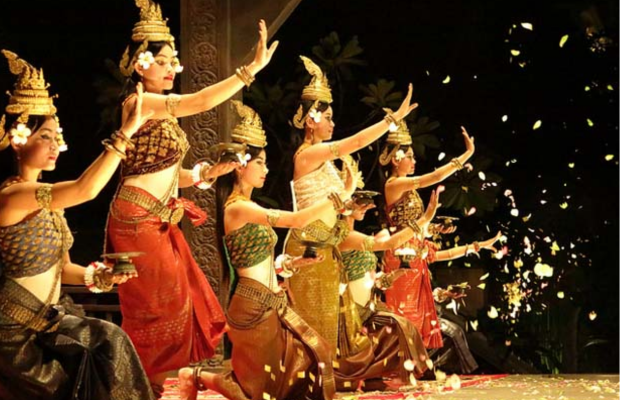
Traditional cultural show with dining
– Giant buffet with great food and a lovely outdoor barbecue area
– The dancing is terrific to see
– Lots of choice for buffet They may make a selection fresh to order, and drinks were good
– Really enjoy the Apsara dance
– Coconut shell dance& fishermen dance
– Arek music, along with the wind & percussion instruments, was mind-blowing
Women performing the ancient art of apsara dance, as depicted on the walls of Angkor’s temples. Wearing glittering silk tunics, sequinned tops (into which they are sewn before each performance to achieve the requisite tight fit) and elaborate golden headdresses, performers execute their movements with deftness and deliberation, knees bent in plié, heels touching the floor first at each step, coy smiles on their faces.
Every position has its own particular symbolism – a finger pointing to the sky, for instance, indicates “today”, while standing sideways to the audience with the sole of the foot facing upwards represents flying.
In the reign of Jayavarman VII there were more than three thousand apsara dancers at court – although dances were performed exclusively for the king, and so prized was their skill that when the Thais sacked Angkor in the fifteenth century, they took a troupe of dancers back home with them. Historically, the art form was taught only at the royal court, but so few exponents survived the ravages of the Khmer Rouge that the genre was very nearly extinguished. Subsequently, when Princess Boppha Devi – who had been a principal dancer with the royal troupe – wished to revive it, she found it helpful to study temple panels to establish the movements.
These days, the Royal University of Fine Arts in Phnom Penh takes much of the responsibility for training dancers, who are chosen not only for aptitude and youth (they start as young as 7), but also for the flexibility and elegance of their hands. It takes six years for students to learn the 1500 positions, and a further three to six years for them to attain the required level of artistic maturity. Also taught is the other principal Cambodian dance genre, tontay, in which the emphasis is on depicting folk tales and episodes from the Reamker. You’ll be able to watch both dance styles in the cultural performances put on by hotels and restaurants in Siem Reap and Phnom Penh.”
Payment: By cash or VISA/ MASTER CARD
Note: Please inform in advance if you wish to pay by your card or go to our Chambak Adventures office
What is included:
KHMER DANCING
The honoured tradition of traditional Khmer dance stretches back over a thousand years to the Age of Angkor when it was popular with Kings and common folk alike. In the tradition of persevering this great cultural heritage, AMAZON ANGKOR Restaurant presents nightly Apsara and traditional dance performances.
Tep Monorom, or Happiness of the Gods and Goddesses dance, is one of the court repertoire’s most popular and beautiful dances . It has been performed as a dance of blessing to end a performance. The distinctive interweaving floor patterns of the Tep Monorom and the complimentary relationship between male and female, in which the male is always on the female’s left, reveal the importance of balance in Khmer social interaction. The chorus describes the erotic pursuit of the heavenly maidens by the male celestials, as well as their harmonious union.
2 – COCONUT DANCE
This popular dance from south-eastern Cambodia is performed at wedding ceremonies. Highly rhythmical and punctuated with shouts and the rapping of coconuts, it expresses joy in life and harmony amongst Cambodians.
3 – MEKHALA DANCE
A metaphor for the victory of good over evil. Armed with a crystal ball casting rays of lightning, the goddess of waters, Moni Mekhala, triumphs over the demon Ream Eysaur, whose axe creates hunger. The two characters illustrate the victory of beneficial rains over the dry and stormy season.
This rural entertainment dance is a lesson of love and courtesy. While exaggerating them, it depicts boys’ and girls’ attitudes to love and courtship. The dance shows a tenacious and mischievous boy courting a shy, earnest young girl.
5 – APSARAS BALLET
This ballet was performed at offering ceremonies and palace celebrations in the Angkorian era. The Apsaras, half-women half-goddesses, are heavenly dancers. Their circular and posied motions, the litheness of their gestures, symbolise their hovering between the cosmos and earth.
Dining starts at 6.00pm
The dance show by 7.30 pm – 8:30 pm. The seating arrangement was excellent.
Mon – Fri: 9am – 5.30pm
Sat: Closed
Sun: Closed
Public Holidays: Closed
Copyright © 2024 Chambak Adventures, All Rights Reserved. Web Designed By: pixelcambo.com